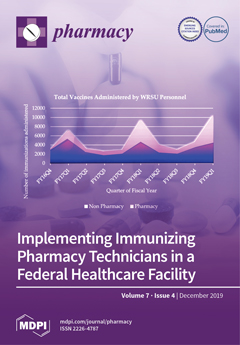Background: Pharmacy technicians are legally allowed to administer immunizations in specific U.S. states, provided they meet certain criteria, including the completion of an accredited immunization training course. Immunizing pharmacy technicians were incorporated into an Indian Health Services federal facility, Whiteriver Service Unit
[...] Read more.
Background: Pharmacy technicians are legally allowed to administer immunizations in specific U.S. states, provided they meet certain criteria, including the completion of an accredited immunization training course. Immunizing pharmacy technicians were incorporated into an Indian Health Services federal facility, Whiteriver Service Unit (WRSU), in 2018. The objective of this research was to gather information about implementing immunizing pharmacy technicians in a federal facility serving a large rural and medically underserved population.
Methods: WRSU launched a Pharmacy Technician Immunization Program in June 2018 after seven federally employed pharmacy technicians participated in the Washington State University accredited technician immunization training. The types of vaccinations administered, and the ages of patients immunized by pharmacy technicians, were tracked from July 1, 2018 to June 30, 2019.
Results: Seven immunization-trained pharmacy technicians administered 4394 injections for a total of 4852 vaccinations in one year. Vaccinations were administered to patients ranging in age from 2 months old to 85 years old and included protection against diphtheria, tetanus, polio, hepatitis A and B, H. influenza, human papillomavirus, seasonal influenza, meningococcal, measles, mumps, rubella, varicella, pneumonia, and rotavirus.
Conclusion: In one year, seven pharmacy technicians administered more than 4800 vaccinations to underserved patients. Pharmacy technicians trained and certified to administer immunizations increase access to vaccination care and have the potential to drastically increase the number of immunizations given and reduce the number of deaths from vaccine-preventable diseases.
Full article





